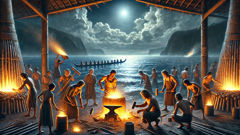Introduction
At the edge of a sleeping volcano and the mouth of a river where the sea tastes of salt and old weather, the Bicol plain once lay tangled in danger and possibility. Villages clustered beneath coconut palms and nipa roofs, their fields of young rice bright as green fire, while elders told of nights when monstrous voices rose from swamp and mountain and when the sea refused to yield fish for hungry hands. This was a land of heat and wind, of heavy rains and stubborn sun, and it was in such a place that the story of Handiong was born: not a mere boast or a single fight but a long-making of peace forged by a man with the hunger to protect his people and the wisdom to call on spirits, neighbors, and craft. Handiong was both common and uncanny: he carried the calluses of a farmer and the steadiness of a leader, and he gave shape to hopes that had long been whispered. Through valleys choked with reeds and mangrove thickets where teeth and talons lurked, through hills that hid caves and old gods, he walked with a step that gathered followers and calmed children. People spoke his name like a promise—one that said, when the darkness comes, someone will stand in the light. In the telling that follows, you will find battles that are as much about wits and cunning as they are about force, encounters with beasts that test the body and hearts that must choose courage over fear, and a landscape remade by sweat, song, and stubborn resolve. This is a retelling that honors the cadence of Bicolano speech, the smell of wet earth after a storm, and the way communities stitch themselves safe by the work of many hands. It is both an homage to the region's living traditions and an original rendering of the epic spirit that kept islands alive in times when monsters were more than myth: they were the dangers that tested the people's resolve, and Handiong became the figure who taught them how to triumph together.
Origins, Oaths, and the First Encounters
Handiong's beginnings were modest: he was born under a sky freckled with lightning, in a hamlet by a crooked river that smelled of mud and sweet fruit. As a boy he learned to read weather by cloud and to listen to the songs of the river when it changed from friend to threat. Once, when the river rose without warning, it carried away a family's homestead and left behind the shape of a problem no single household could fix. From these small disasters grew a sense of mutual obligation, and Handiong learned early that doing nothing to help a neighbor was to let danger multiply. When he reached his full height he moved among villages, gathering people to clear channels and to plant trees that would hold soil and steady the land. His voice carried easily across market squares, and when he spoke, people felt a warmth like bread fresh from the oven; his ideas were practical—dikes, footbridges, watch platforms at river mouths—but they were also threaded through with story. He told of the old days when creatures of the dark came out from caves and mangroves and made the roads unsafe for travelers. His listeners heard the danger in the details and felt, with sharp clarity, that their fate could be altered.

It was not long before Handiong encountered the first of the monsters the elders had half-sung about. They called it the Great Reek, a creature born from the swamp's own hunger: a mass of vines and teeth, with eyes like milky orbs and a mouth that gurgled with syllables no human tongue could hold. Villagers who tried to chase it away found their ropes turned to wet reeds and their spears to soft sap. Handiong watched, learned the creature's patterns, and then did what he always did—he mapped the problem and enlisted many hands. They dug a proper trench to drain the worst of the swamp, launched nets braided with salt and sea herbs, and placed smoldering coils of bamboo at likely resting places. On the night of the first confrontation, Handiong led a group who used reflected moonlight to confuse the Reek's pale eyes, guiding it toward the trap where the nets and woven charms held. The monster fought like the wind with claws of rot, but together the people pulled and refused to let go. When the beast finally gave up its hold, it dissolved into drowned reeds and sweet water, and though it left a scent of old mud, the swamp felt less hungry than before. Word spread of Handiong's way—patience first, then strength combined with community.
There were other monsters that demanded different kinds of courage. A cliff-dwelling thing that sang to children and led them into caves was outwitted with songs older than the creature's lullabies: mothers and grandmothers taught a counter-song, a rhythmic call that carried a binding magic for those who knew the words. A water-serpent that had poisoned a fishing bank was not slain but negotiated with—Handiong and the village elders placed offerings of fish and fruit, made a pact that the serpent would take only certain tides, and in exchange the people would avoid its lairs. These solutions were as much about respect and reciprocity as they were about force. Handiong's courage was not always the loud kind; sometimes it was a steadier resolve to sit with a danger until its nature was clear and a consensus formed. He kept a small council of wise women and men—diwata-keepers, former fishermen scarred by sea storms, blacksmiths who could tune a blade or make a lever. There is a moral in the old telling: the wild has rules, and those who wish to tame it must learn them rather than pretend to own them. Handiong's early victories were the result of listening, labor, and the willingness to harness the collective will of a people. As the seasons turned, he grew in fame and drew more followers, artisans and storytellers who recorded his deeds in chant and carved scenes of battles into bamboo and wood. But reputation and alliances invited envy. Distant leaders, fearful of his growing influence, and creatures beyond the known marshes began to stir. Handiong had to prepare not only for beasts of reed and fang, but for larger tests—storms of men and monsters alike.
The Great Campaigns: Mountains, Caves, and the Making of New Ways
As Handiong's legend spread, whole regions asked for his aid. He did not always answer with arms alone; sometimes he traveled to teach how to build paths safe for trade, how to store seed against flood, and how to shape laws that kept stronger men from taking what weaker ones needed. But when the mountain-brood awoke, it became clear that the epics of his youth had prepared him for more than clearing swamps and striking bargains. The first great test of his matured leadership came when the mountain caves themselves seemed to speak. A brood of night-dwelling things—furred and scaled, with claws that chiseled stone into grim faces—had started to slip down into villages during harvest, stealing granaries and leaving crops half-eaten. They painted themselves with ash and set traps that resembled farming tools so the villagers would think the thefts were rotational pests. Only Handiong saw the pattern: an intelligence behind the raids, a communal cunning that matched human craft.

He assembled a long column of people, not all of them warriors. There were potters who could fashion hard clay shells, rope-makers who could braid anchorage strong enough to pull a portable rampart, women who understood the moon-tides and the animal tracks, and young singers whose melodies could call the earth to listen. They walked high into mountain passes under a sky that smelled of sulfur and pine. There, at the place where the caves breathed their coldest air, Handiong divided the force into careful groups. One team made mirrors out of polished metal and broken pottery to reflect the creatures' own crouches and confuse them; another team made good use of smoke from pandan leaves and burnt coconut shells to mask human scent and flush the beasts into narrow clefts where the rope-makers had prepared snares. When the moment came to close the mouths of the caves, it was done with both cunning and mercy. Handiong's men did not seek to eradicate life; they sought to confine the danger and offer the creatures a way out that did not require their annihilation. They channeled a small underground stream to open a new cavern passage the creatures could inhabit away from human pathways. In barter ritual the animals were given new territory and were promised certain nights of harvest-offering to keep their hunger controlled. This act of shaping a solution, rather than merely striking at a problem, became Handiong's signature.
In the midst of these campaigns, Handiong faced perhaps his most fearsome opponent: a coastal behemoth known in whispers as Lupa-Tala, a creature of rock and tide that shook cliffs and swallowed boats at moon-high tide. Sailors saw its rise as the sudden crouch of mountain and wave; they would return ashore with nets torn like paper. To rid the coast of this terror, Handiong harnessed both human art and the belief of the sea folk. He gathered oarsmen, fisherwomen who understood the secret currents, and blacksmiths who had learned to temper iron with salt. They forged a spear with a head carved from the hardest coastal basalt and fitted its haft with braided rattan that would not slip even under sea-spray. But the spear alone was not enough. Handiong called upon the mer-spirit told of in lullabies: a diwata who had once loved a fisherman and understood both the stubborn preservation of rock and the fluid patience of water. She taught the fighters a rhythm to row and bear the spear, a cadence that made the sea lean to human will rather than fight it. At the appointed hour, under a twilight sky, the men rowed in unison so that the tide itself seemed to carry them forward. The spear struck the beast where its skin met the shell of cliff; with a sound like a fallen mountain the creature retreated into a deep trench and did not rise again. In doing so, Handiong did not claim the sea for himself but negotiated its new boundaries. He inscribed simple rules: fishers would leave certain reefs untouched for spawning, and in return the sea would spare their boats from the worst of its moods.
Handiong's campaigns were thus a weaving of craft, ritual, and practical law. He persuaded farmers to terrace the hills to prevent runaway rains and taught fishers to use seasonal knowledge instead of constant plunder. But the most lasting of his acts was social: he transformed fear into shared responsibility. Villages started to hold festivals not just to praise victory but to renew pacts—pacts with the land, pacts with the spirits, and pacts with one another. He fostered an oral law that said protect the young, keep the roads lit, and do not take another's seed in times of scarcity. In these ways a previously scattered region began to behave like a single, careful body. Poets carved these deeds into chant, and mothers hummed them into the ears of sleeping children. The legend grew not because Handiong became infallible but because he taught people how to bear dangers together. Even when new threats came, the communities looked first to their shared tools and their songs before they called only on a single sword. In the long view, Handiong's greatest victory was not a final conquest of monsters but the creation of systems—rituals, laws, farming practices—that made monsters less likely to find purchase in human life. The landscape itself changed: mangroves stood where salt had once chewed the shore, terraces held the hills, and lanes that once required torchlight were now lit by lamps and the steady tread of neighbors walking with each other at dusk.
Conclusion
In the years after his great campaigns, Handiong became a figure who moved across memory like a slow rain—soaking into the land, the language, and the laws of the people. Children grew up reciting how the swamp was tamed and how the sea agreed to limits; women and men learned new trades and passed them down like heirlooms. The epic that tells of Handiong is not merely about the slaying of monsters but about how a people learned to adjust their customs and craft so danger would have less room to grow. Courage, in the tale, is a communal muscle built by habit, ritual, and mutual accountability. When modern travelers walk the ridgelines of Bicol, they see terraces and mangrove stands and hear songs at night; these living features are as much the trace of Handiong's work as any carved image. He remains an emblem of practical heroism: someone who knows the land and who teaches others how to live well upon it. The story also keeps a cautionary edge; it reminds listeners that the world still holds things that will test their resolve and that the most enduring victories come from blending respect for the wild with persistent, shared labor. Handiong's legacy is therefore not a single glorious age but an ongoing habit of resilience—one that asks every generation to listen, to gather, and to act together with courage tempered by care.













